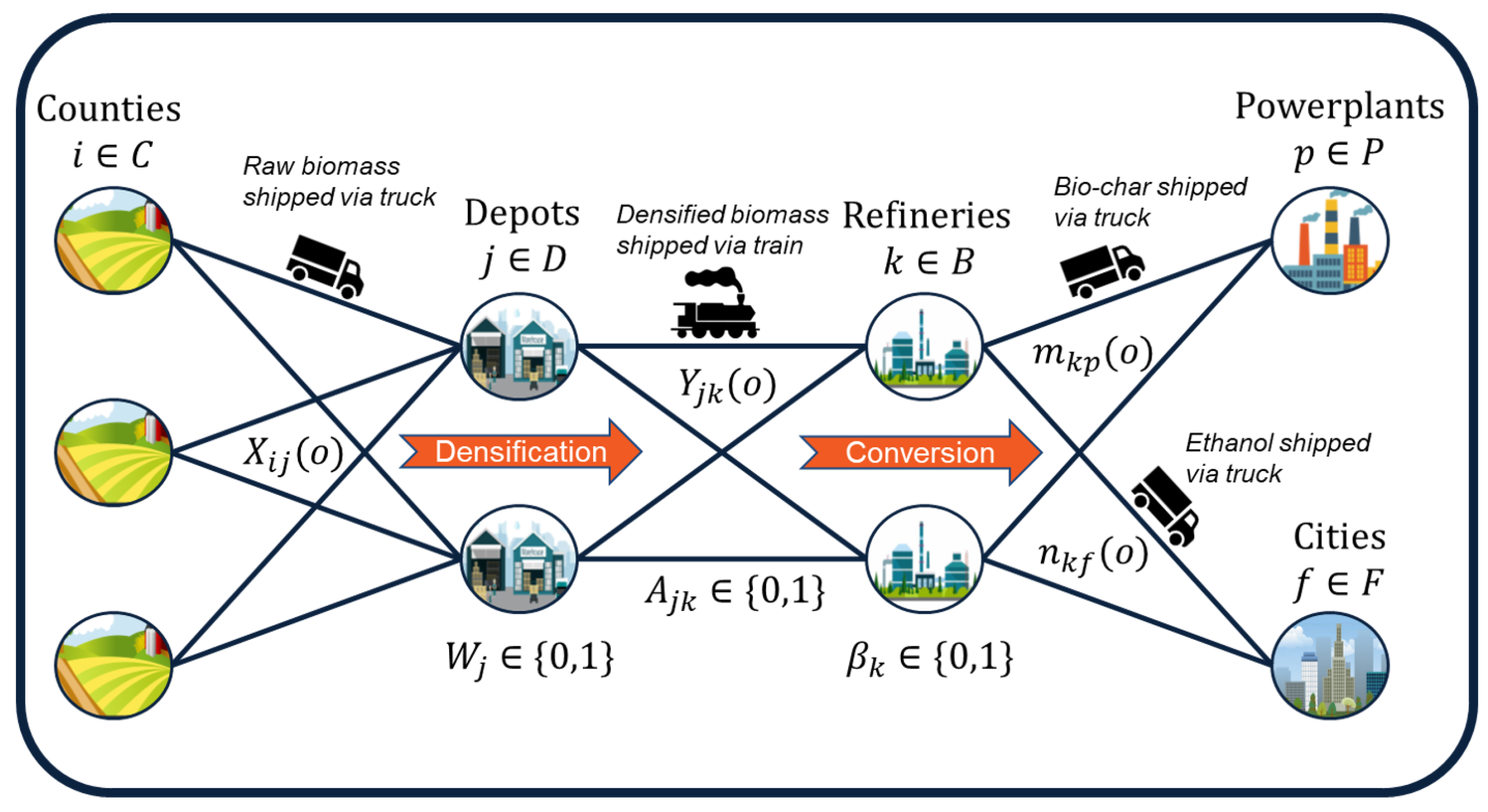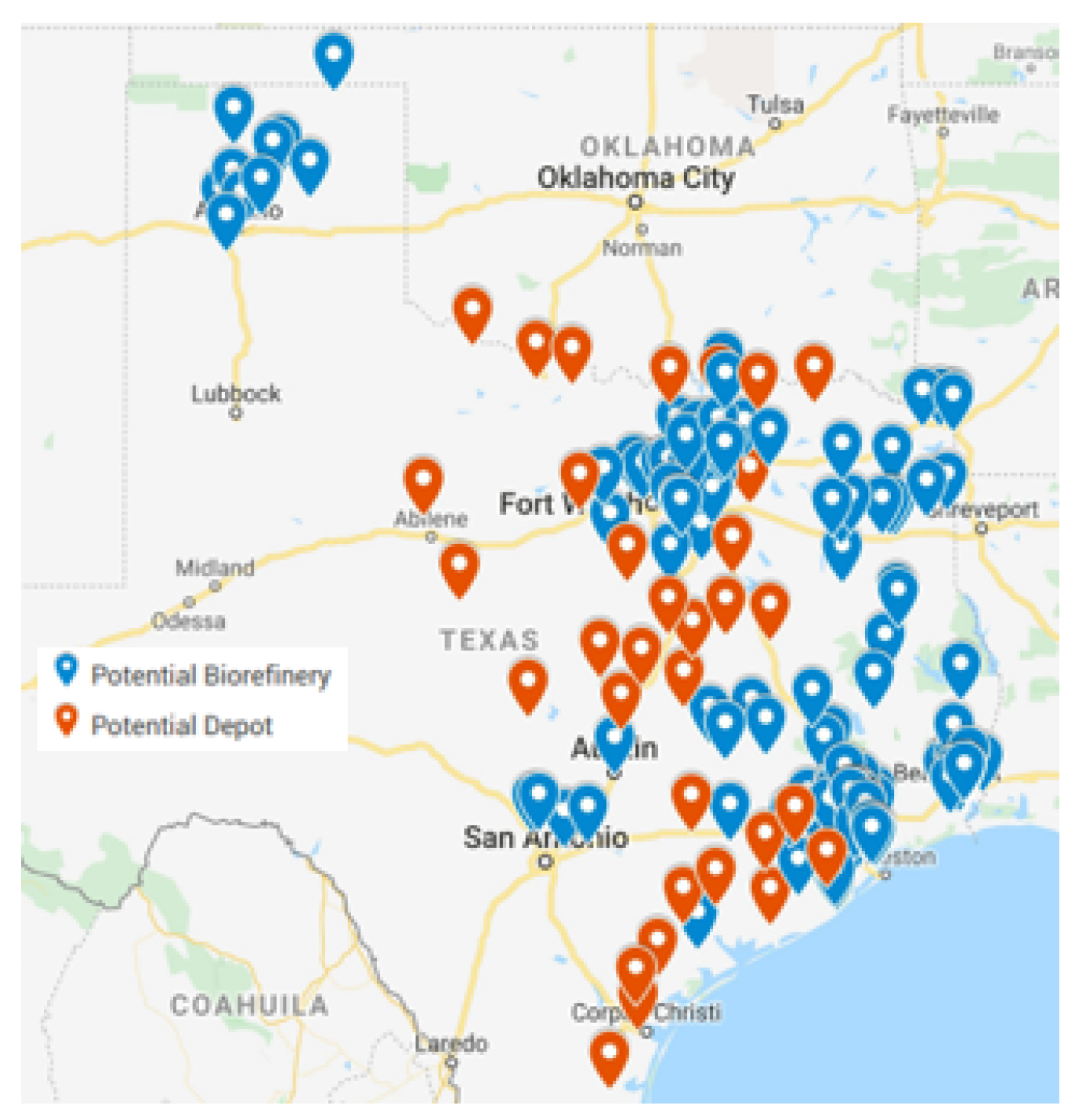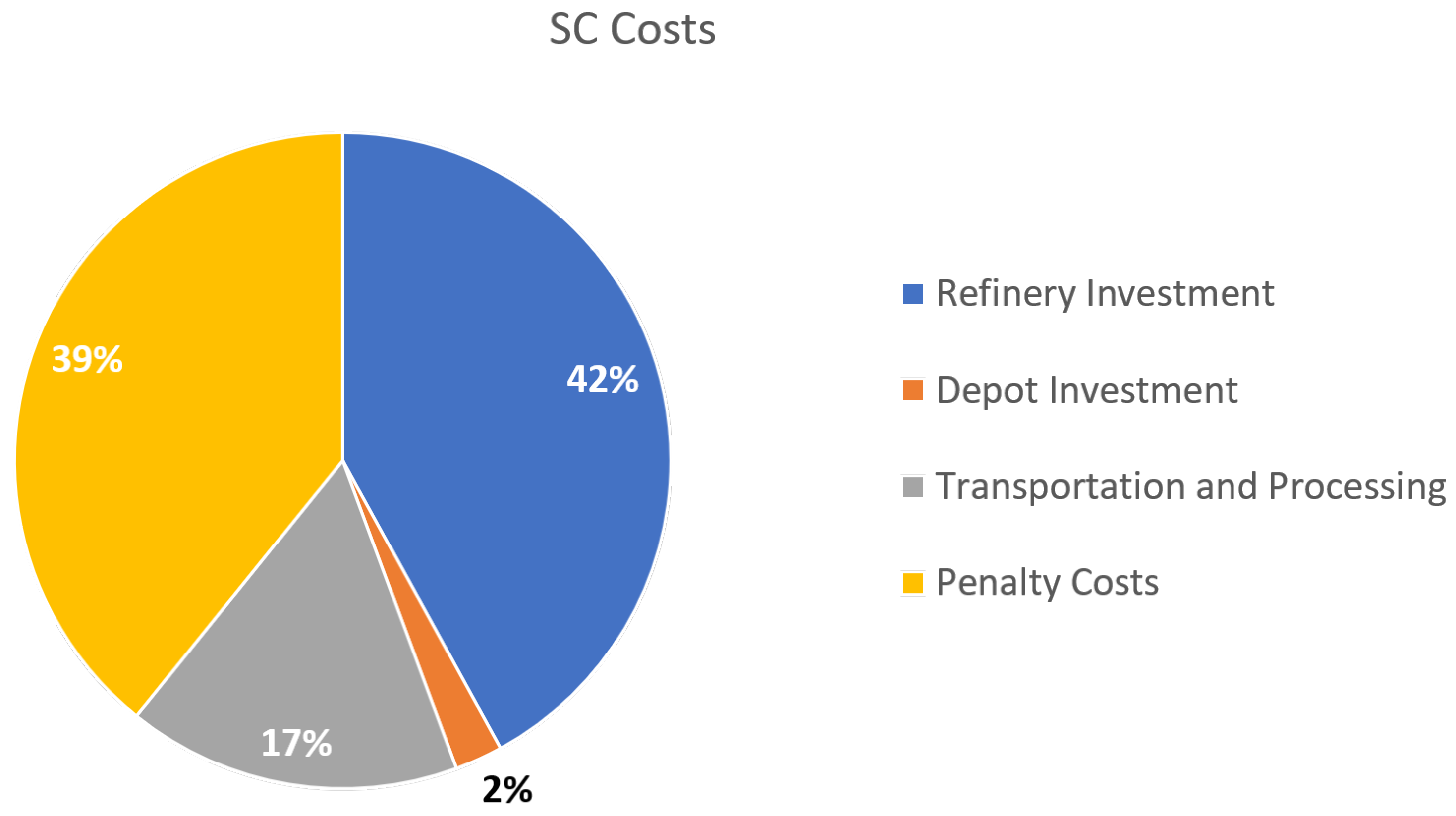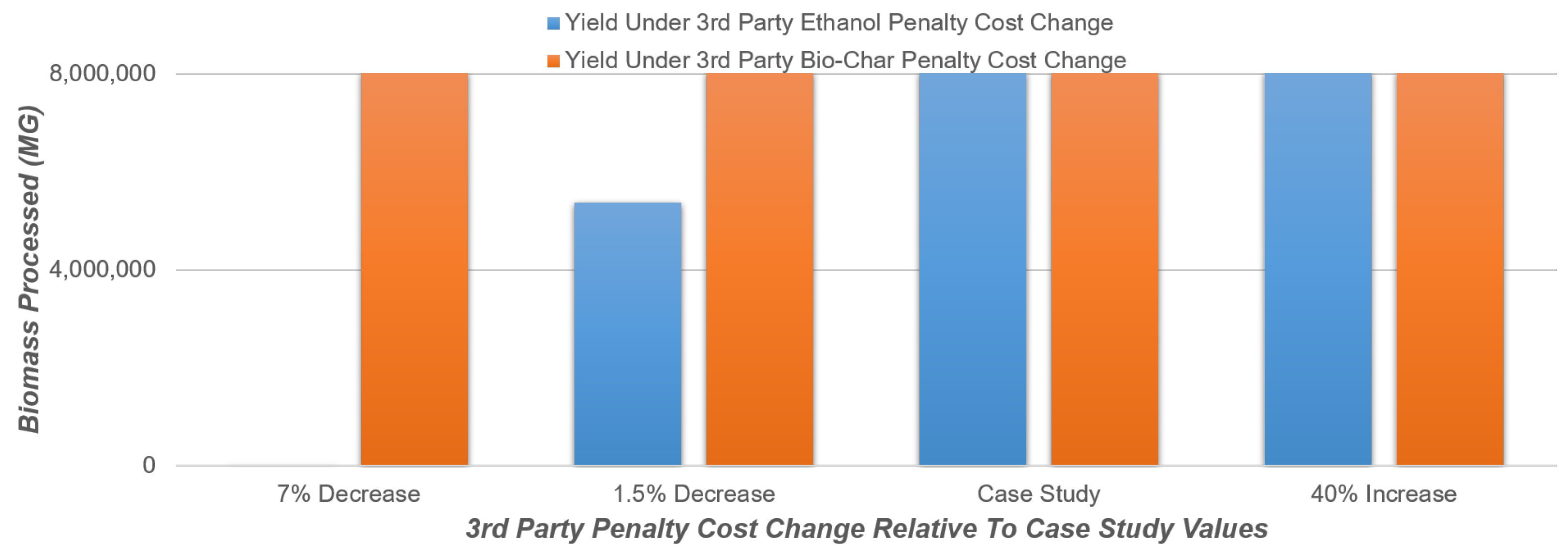Stochastic Programming Model Integrating Pyrolysis Byproducts in the Design of Bioenergy Supply Chains
Abstract
:1. Introduction
1.1. Literature Review
1.2. Contributions
2. Mathematical Model
- : Nodes of distribution network , for all .
- : Arcs of distribution network , for all .
- : Set of counties(suppliers) for all .
- : Set of potential locations for depots, for all .
- : Set of potential locations for biorefineries, .
- : Set of power plants (coal), .
- : Set of cities, .
- : Set of arcs from to , .
- : Set of arcs from to , .
- : Set of arcs from to , .
- : Set of arcs from to , .
- : Set of technologies for conversion, .
- : Set of scenarios, .
- : Investment cost to open a depot at node .
- : Investment cost to open a biorefinery at location utilizing technology .
- : Fixed cost of loading/unloading a unit train along arc every week for a period of one year (52 weeks).
- : Unit transportation and procurement cost charged per metric ton shipped along arc .
- : Total unit cost charged per metric ton shipped along arc .
- : Fixed unit cost charged per metric ton shipped along arc .
- : Fixed unit cost charged per metric ton shipped along arc .
- : Variable unit cost charged per metric ton per kilometer along arc .
- : Variable unit cost charged per liter per kilometer along .
- : Distance of arc (kilometers) .
- : Distance of arc (kilometers) .
- : Represents the penalty cost for demand shortage of coal.
- : Represents the penalty cost for demand shortage of bioethanol.
- : Represents the monetary value per liter of biodiesel.
- : Conversion factor for biomass/biochar supplied to power plant applying pyrolysis.
- : Conversion factor for biomass pyrolysis oil to bioethanol.
- : Conversion factor for biomass pyrolysis oil to biodiesel.
- : Maximum capacity of a unit train along arc .
- : Represents the preprocessing capacity of depot facility .
- : Production capacity of biorefinery including technology .
- : Distance from biorefinery to power plant.
- : Distance from biorefinery to city.
- : Total demand of biochar.
- : Total demand of bioethanol.
- : Byproduct share of biochar.
- : Byproduct share of bio-oil.
- : Total unit cost charged per metric ton shipped along arc under scenario .
- : Available supply in county for scenario .
- : Probability of scenario .
- : Target moisture content of conversion technology.
- : Target ash content of conversion technology.
- : Boiler maintenance cost.
- : Densification cost at .
- : Cooling cost at .
- : Electricity cost at .
- : Grinding loss in stage 1 at .
- : Grinder feed rate at .
- : Moisture-related cost under scenario for a given .
- : Grinding cost under scenario .
- : Energy consumption due to the grinder at by processing biomass delivered from farm .
- : Moisture content of biomass coming from farm for scenario .
- : Energy consumption due to the rotary shear at .
- : Moisture content of biomass after grinder at .
- : Biomass screen size after grinder at under scenario .
- : Ash removal and disposal cost under scenario for a given .
- : Ash content of biomass coming from county for scenario .
- : A binary variable, which takes the value 1 if a depot is connected with a biorefinery , and 0 otherwise.
- : A binary variable which takes the value 1 if if the potential location is used as a biorefinery utilizing technology , and 0 otherwise.
- : A binary variable which takes the value 1 if potential location is used as depot, and 0 otherwise.
- : Flow along arc under scenario .
- : Flow along arc under scenario .
- : Flow along arc under scenario .
- : Flow along arc under scenario .
- : Variable cost incurred by product shipped along arc after diesel related cost reduction under scenario .
- : Variable cost incurred by product shipped along arc after diesel related cost reduction under scenario .
- : Quantity of biodiesel allocated to shipping cost reduction along arc under scenario .
- : Quantity of biodiesel allocated to shipping cost reduction along arc under scenario .
- : Third party coal supply under scenario .
- : Third party bioethanol supply under scenario .
Costs along Arc
3. Case Study
3.1. Biomass Supply
- The available biomass.
- The biomass moisture content.
- The biomass ash content.
- The weather condition scenario.
3.2. Scenario Generation
- Gather historical data of the daily precipitation level of every county.
- Use the historical data to estimate the weighted average yearly precipitation for every county.
- Depending on the levels of daily precipitation, a county is classified as humid or dry. If the value is above average, the county is considered humid and vice-versa.
- Calculate the frequency of a county’s humid conditions for harvesting.
- Set the number of scenarios.
- Generate n random numbers to classify a county as humid or dry. A random number above the probability assigns a county as dry and a lower number assigns a county as humid.
- The moisture content of a humid county is sampled from the right-hand side of the triangular distribution and vice-versa.
- The triangular distribution is used to generate a random ash content.
3.3. Depots
3.4. Biorefineries
3.5. Transportation and Other Costs
3.6. Power Plants
3.7. Cities
4. Results
4.1. Numerical Results
4.2. Sensitivity Analysis
5. Conclusions and Future Work
Author Contributions
Funding
Data Availability Statement
Acknowledgments
Conflicts of Interest
References
- EIA. Crude Oil Made into Different Fuels; EIA: Washington, DC, USA, 2019.
- Roni, M.S.; Eksioglu, S.D.; Cafferty, K.G. A Multi-Objective, Hub-and-Spoke Supply Chain Design Model for Densified Biomass. In Proceedings of the IIE Annual Conference, Montreal, QC, Canada, 31 May–3 June 2014; Institute of Industrial and Systems Engineers (IISE): Norcross, GA, USA, 2014; p. 643. [Google Scholar]
- Environmental Defense Fund. The True Cost of Carbon Solution; Environmental Defense Fund: New York, NY, USA, 2023. [Google Scholar]
- Environmental Protection Agency. Greenhouse Gases; Environmental Protection Agency: Washington, DC, USA, 2020.
- U.S. Energy Information Administration. 2020. Available online: https://www.eia.gov/energyexplained/us-energy-facts/data-and-statistics.php (accessed on 7 May 2020).
- Independence, E.; Act, S. Energy Independence and Security Act of 2007; US Government Printing Office: Washington, DC, USA, 2007.
- Brownsort, P.A. Biomass Pyrolysis Processes: Review of Scope, Control and Variability; UK Biochar Research Center: Edinburgh, UK, 2009; p. 38. [Google Scholar]
- Miles, T.R.; Miles, T., Jr.; Baxter, L.; Bryers, R.; Jenkins, B.; Oden, L. Alkali Deposits Found in Biomass Power Plants: A Preliminary Investigation of Their Extent and Nature; Technical Report; National Renewable Energy Lab.: Golden, CO, USA; Miles (Thomas R.): Portland, OR, USA; Sandia National Labs.: Livermore, CA, USA; Foster Wheeler Development Corp.: Livingston, NJ, USA; California Univ.: Davis, CA, USA; Bureau of Mines: Albany, OR, USA; Albany Research Center: Albany, OR, USA, 1995; Volume 1. [Google Scholar]
- Zhao, P.; Shen, Y.; Ge, S.; Chen, Z.; Yoshikawa, K. Clean solid biofuel production from high moisture content waste biomass employing hydrothermal treatment. Appl. Energy 2014, 131, 345–367. [Google Scholar] [CrossRef]
- Panichelli, L.; Gnansounou, E. GIS-based approach for defining bioenergy facilities location: A case study in Northern Spain based on marginal delivery costs and resources competition between facilities. Biomass Bioenergy 2008, 32, 289–300. [Google Scholar] [CrossRef]
- Cundiff, J.S.; Dias, N.; Sherali, H.D. A linear programming approach for designing a herbaceous biomass delivery system. Bioresour. Technol. 1997, 59, 47–55. [Google Scholar] [CrossRef]
- Akgul, O.; Shah, N.; Papageorgiou, L. An MILP Model for the Strategic Design of the UK Bioethanol Supply Chain. Comput. Aided Chem. Eng. 2011, 29, 1799–1803. [Google Scholar]
- Leduc, S.; Schwab, D.; Dotzauer, E.; Schmid, E.; Obersteiner, M. Optimal location of wood gasification plants for methanol production with heat recovery. Int. J. Energy Res. 2008, 32, 1080–1091. [Google Scholar] [CrossRef]
- Larkin, S.; Ramage, J.; Scurloc, J. Bioenergy. In Renewable Energy-Power for a Sustainable Future; Oxford University Press: Oxford, UK, 2004; pp. 106–146. [Google Scholar]
- Awudu, I.; Zhang, J. Uncertainties and sustainability concepts in biofuel supply chain management: A review. Renew. Sustain. Energy Rev. 2012, 16, 1359–1368. [Google Scholar] [CrossRef]
- Andersen, F.; Iturmendi, F.; Espinosa, S.; Diaz, M. Optimal design and planning of biodiesel supply chain with land competition. Chem. Eng. 2012, 47, 170–182. [Google Scholar] [CrossRef]
- Bowling, I.M.; Ponce-Ortega, J.M.; El-Halwagi, M.M. Facility Location and Supply Chain Optimization for a Biorefinery. Am. Chem. Soc. 2011, 50, 6276–6286. [Google Scholar] [CrossRef]
- Castillo-Villar, K.K.; Eksioglu, S.; Taherkhorsandi, M. Integrating biomass quality variability in stochastic supply chain modeling and optimization for large-scale biofuel production. J. Clean. Prod. 2017, 149, 904–918. [Google Scholar] [CrossRef]
- Aboytes-Ojeda, M.; Castillo-Villar, K.K.; Eksioglu, S.D. Modeling and optimization of biomass quality variability for decision support systems in biomass supply chains. Ann. Oper. Res. 2022, 314, 319–346. [Google Scholar] [CrossRef]
- Marufuzzaman, M.; Eksioglu, S.D.; Huang, Y.E. Two-stage stochastic programming supply chain model for biodiesel production via wastewater treatment. Comput. Oper. Res. 2014, 49, 1–17. [Google Scholar] [CrossRef]
- Casler, M.; Boe, A. Cultivar × environment interactions in switchgrass. Crop Sci. 2003, 43, 2226–2233. [Google Scholar] [CrossRef]
- Roni, M.S. Analyzing the Impact of a Hub and Spoke Supply Chain Design for Long-Haul, High-Volume Transportation of Densified Biomass; Mississippi State University: Starkville, MS, USA, 2013. [Google Scholar]
- Roni, M.S.; Thompson, D.N.; Hartley, D.; Griffel, M.; Hu, H.; Nguyen, Q.; Cai, H. Herbaceous Feedstock 2018 State of Technology Report; Technical Report; Idaho National Laboratory: Idaho Falls, ID, USA, 2018. [Google Scholar]
- U.S. Census Bureau. U.S. Gazetteer: 2010, 2000, and 1990; U.S. Census Bureau: Suitland, MD, USA, 2012.
- Langholtz, M.H.; Stokes, B.J.; Eaton, L.M.; Brandt, C.C.; Davis, M.R.; Theiss, T.J.; Turhollow, A.F., Jr.; Webb, E.; Coleman, A.; Wigmosta, M.; et al. 2016 Billion-Ton Report: Advancing Domestic Resources for a Thriving Bioeconomy, Volume 1: Economic Availability of Feedstocks; Technical Report; Oak Ridge National Lab. (ORNL): Oak Ridge, TN, USA, 2016. [Google Scholar]
- Centers for Disease Control and Prevention. NLDAS Daily Precipitation; Centers for Disease Control and Prevention: Atlanta, GA, USA, 2016.
- U.S. Department of Energy. 2017. Available online: https://bioenergykdf.net/billionton2016/overview (accessed on 10 May 2020).
- Center of Transportation Analysis. Railroad Network 2017. Available online: http://cta.ornl.gov/transnet/RailRoads.html (accessed on 2 May 2017).
- Lamers, P.; Roni, M.S.; Tumuluru, J.S.; Jacobson, J.J.; Cafferty, K.G.; Hansen, J.K.; Kenney, K.; Teymouri, F.; Bals, B. Techno-economic analysis of decentralized biomass processing depots. Bioresour. Technol. 2015, 194, 205–213. [Google Scholar] [CrossRef] [PubMed]
- National Renewable Energy Laboratory. 2017. Available online: https://maps.nrel.gov/bioenergyatlas (accessed on 3 March 2017).
- Jones, S.B.; Meyer, P.A.; Snowden-Swan, L.J.; Padmaperuma, A.B.; Tan, E.; Dutta, A.; Jacobson, J.; Cafferty, K. Process Design and Economics for the Conversion of Lignocellulosic Biomass to Hydrocarbon Fuels: Fast Pyrolysis and Hydrotreating Bio-Oil Pathway; Technical Report; Pacific Northwest National Laboratory (PNNL): Richland, WA, USA, 2013. [Google Scholar]
- Boateng, A.A.; Daugaard, D.E.; Goldberg, N.M.; Hicks, K.B. Bench-scale fluidized-bed pyrolysis of switchgrass for bio-oil production. Ind. Eng. Chem. Res. 2007, 46, 1891–1897. [Google Scholar] [CrossRef]
- Project-OSRM. Project-OSRM/osrm-backend. 2017. Available online: https://github.com/Project-OSRM/osrm-backend (accessed on 14 March 2017).
- R Core Team. The R Project for Statistical Computing; R Core Team: Vienna, Austria, 2017. [Google Scholar]
- Huang, Y.; Chen, C.W.; Fan, Y. Multistage optimization of the supply chains of biofuels. Transp. Res. Part E Logist. Transp. Rev. 2010, 46, 820–830. [Google Scholar] [CrossRef]
- Abbas, D.; Handler, R.; Dykstra, D.; Hartsough, B.; Lautala, P. Cost Analysis of Forest Biomass Supply Chain Logistics. J. For. 2013, 111, 271–281. [Google Scholar] [CrossRef]
- Searcy, E.; Flynn, P.; Ghafoori, E.; Kumar, A. The relative cost of biomass energy transport. Appl. Biochem. Biotechnol. 2007, 137, 639–652. [Google Scholar] [PubMed]
- EIA. Coal Prices and Outlook. In U.S. Energy Information Administration—EIA—Independent Statistics and Analysis; EIA: Washington, DC, USA, 2019. [Google Scholar]
- EIA. Texas State Energy Profile. 2019. Available online: www.eia.gov/state/print.php?sid=TX (accessed on 14 March 2018).
- Sawe, B.E. Biggest Cities in Texas. WorldAtlas 2016. Available online: https://www.worldatlas.com/cities/10-largest-cities-in-texas.html (accessed on 3 March 2017).






| Authors | Bowling, and El-Halwagi 2011 [17] | Castillo-Villar, Eksioglu, Taherkhorsandi, 2017 [18] | Aboytes-Ojeda, Castillo-Villar Eksioglu, 2018 [19] | This Work |
|---|---|---|---|---|
| Hub-and-spoke network | X | X | X | X |
| Considers variability in moisture and ash content | X | X | X | |
| Utilizes depots to reduce transportation costs and processing variability | X | X | ||
| Uses L-shape Method | X | X | X | |
| Considers multiple biomass byproducts | X |
| Cost | Type | Value | Units |
|---|---|---|---|
| Natural Gas | Variable | 10.37 | $/Mg Dry Biomass |
| Chemicals | Variable | 33.17 | $/Mg Dry Biomass |
| Waste | Variable | 1.04 | $/Mg Dry Biomass |
| Electricity | Variable | 9.32 | $/Mg Dry Biomass |
| Fixed Costs | Fixed | 39,312,000 | $/Year |
| Depreciation | Fixed | 25,974,000 | $/Year |
| Taxes | Fixed | 7,722,000 | $/Year |
Disclaimer/Publisher’s Note: The statements, opinions and data contained in all publications are solely those of the individual author(s) and contributor(s) and not of MDPI and/or the editor(s). MDPI and/or the editor(s) disclaim responsibility for any injury to people or property resulting from any ideas, methods, instructions or products referred to in the content. |
© 2023 by the authors. Licensee MDPI, Basel, Switzerland. This article is an open access article distributed under the terms and conditions of the Creative Commons Attribution (CC BY) license (https://creativecommons.org/licenses/by/4.0/).
Share and Cite
Keith, K.; Castillo-Villar, K.K. Stochastic Programming Model Integrating Pyrolysis Byproducts in the Design of Bioenergy Supply Chains. Energies 2023, 16, 4070. https://doi.org/10.3390/en16104070
Keith K, Castillo-Villar KK. Stochastic Programming Model Integrating Pyrolysis Byproducts in the Design of Bioenergy Supply Chains. Energies. 2023; 16(10):4070. https://doi.org/10.3390/en16104070
Chicago/Turabian StyleKeith, Kolton, and Krystel K. Castillo-Villar. 2023. "Stochastic Programming Model Integrating Pyrolysis Byproducts in the Design of Bioenergy Supply Chains" Energies 16, no. 10: 4070. https://doi.org/10.3390/en16104070







